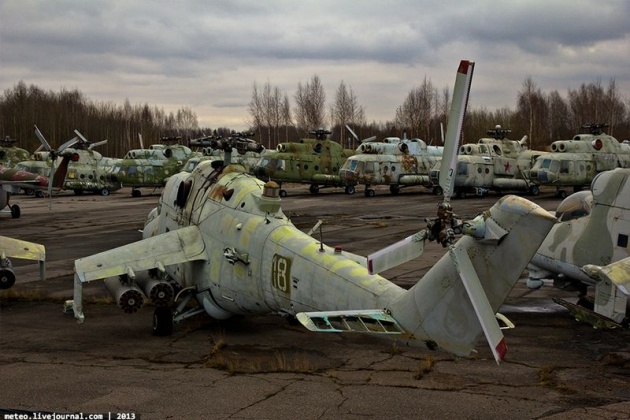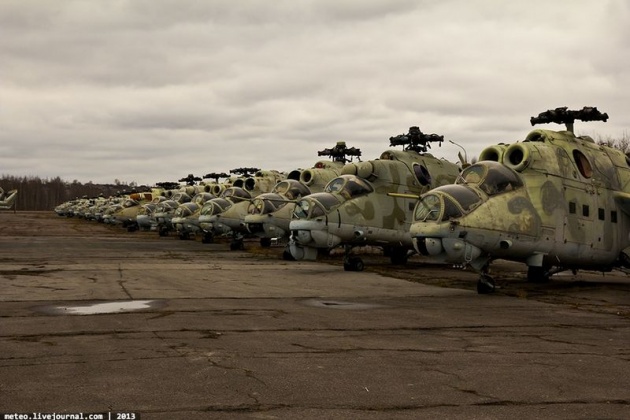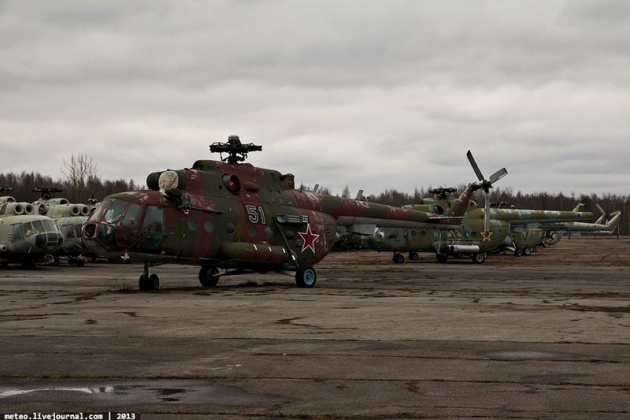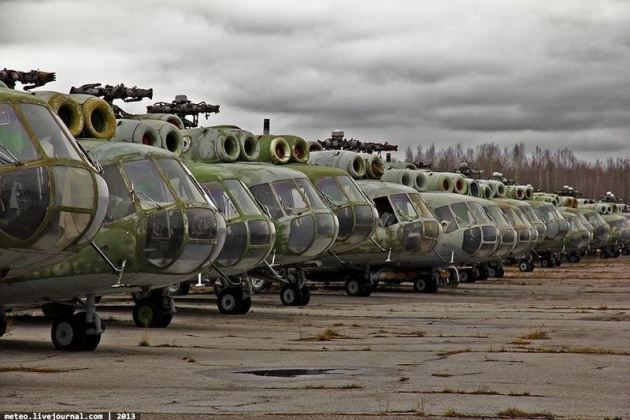This abandoned airfield is not far from Saint Peters burg.
During the early 1960s, Soviet engineers started experimenting with various designs aimed at producing an aerial vehicle that can provide battlefield mobility for infantry and provide fire support to army forces on the ground. The first of these concepts was a mock-up unveiled in 1966 in the experimental shop of the Ministry of Aircraft’s factory number 329 where Soviet designer, Mikhail Leont’yevich Mil, was head designer.
The mock-up, which was designated V-24, was based on another project, the V-22 utility helicopter, which itself never entered production. The V-24 had an infantry transport compartment that could hold eight troops sitting back to back, and a set of small wings positioned to the top rear of the passenger cabin, capable of holding up to six missiles or rocket pods and a twin-barrel GSh-23L cannon fixed to the landing skid.
The development of gunships and attack helicopters by the US Army during the Vietnam War convinced the Soviets of the advantages of armed helicopter ground support doctrine, which had a positive influence on moving forward with the development of the Mil Mi-24. After several mock-ups were produced, a directive was issued on 6 May 1968 to proceed with development of a twin-engine design of the helicopter. Work proceeded under Mil until his death in 1970.
Detailed design work began in August 1968 under the codename Yellow 24. A full-scale mock-up of the design was reviewed and approved in February 1969. Flight tests with a prototype began on 15 September 1969 with a tethered hover, and four days later the first free flight was conducted.A second prototype was built, followed by a test batch of ten helicopters. A number of other design changes were made until the production version Mi-24A entered production in 1970, obtaining its initial operating capability in 1971 and was officially accepted into the state arsenal in 1972.
In 1972, following completion of the Mi-24, development began on a unique attack helicopter with transport capability. The new design had a reduced transport capability (3 troops instead of 8) and was called the Mil Mi-28, and that of the Ka-50 attack helicopter, which is smaller and more manoeuvrable and does not have the large cabin for carrying troops.
In 1977, a preliminary design of the Mil Mi-28 was chosen, in a classic single-rotor layout. Its transport capability was removed and it lost its similarity to the Mi-24. Design work on the Mi-28 began under Marat Tishchenko in 1980.[12] In 1981, a design and a mock-up were accepted. The prototype (no. 012) was first flown on 10 November 1982.
In this same time frame, Kamov was also attempting to submit its own designs for a new helicopter to the military, which they had designed throughout the early and mid 1980s. In 1984, the Mi-28 completed the first stage of state trials, but in October 1984 the Soviet Air Force chose the more advanced Kamov Ka-50 as the new anti-tank helicopter.
The Mi-28 development was continued, but given lower priority. In December 1987 Mi-28 production in Rosvertol inRostov on Don was approved. After several prototypes were built, production ceased in 1993 with additional development continuing into the 21st century.
Changes in the military situation after the Cold War made specialized anti-tank helicopters less useful. The advantages of the Mi-28N, like all-weather action ability, lower cost, and similarity to the Mi-24, have become more important. In 2003, the head ofRussian Air Force stated that the Mi-28N and Ka-50 attack helicopters will become the standard Russian attack helicopter








